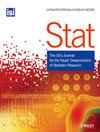A latent space accumulator model for response time: Applications to cognitive assessment data
IF 0.8
4区 数学
Q3 STATISTICS & PROBABILITY
引用次数: 0
Abstract
Response time has attracted increased interest in educational and psychological assessment for, for example, measuring test takers' processing speed, improving the measurement accuracy of ability and understanding aberrant response behaviour. Most models for response time analysis are based on a parametric assumption about the response time distribution. The Cox proportional hazard model has been utilized for response time analysis for the advantages of not requiring a distributional assumption of response time and enabling meaningful interpretations with respect to response processes. In this paper, we present a new version of the proportional hazard model, called a latent space accumulator model, for cognitive assessment data based on accumulators for two competing response outcomes, such as correct versus incorrect responses. The proposed model extends a previous accumulator model by capturing dependencies between respondents and test items across accumulators in the form of distances in a two-dimensional Euclidean space. A fully Bayesian approach is developed to estimate the proposed model. The utilities of the proposed model are illustrated with two real data examples.响应时间的潜在空间累加器模型:在认知评估数据中的应用
反应时间在教育和心理评估中引起了越来越多的兴趣,例如,测量考生的处理速度,提高能力测量的准确性和理解异常反应行为。大多数响应时间分析模型都是基于响应时间分布的参数假设。由于不需要响应时间的分布假设和能够对响应过程进行有意义的解释,Cox比例风险模型已被用于响应时间分析。在本文中,我们提出了一个新版本的比例风险模型,称为潜在空间累加器模型,用于基于累加器的两种竞争反应结果的认知评估数据,如正确反应和不正确反应。提出的模型通过在二维欧几里德空间中以距离的形式捕获累加器之间的应答者和测试项之间的依赖关系来扩展先前的累加器模型。开发了一种完全贝叶斯方法来估计所提出的模型。通过两个实际数据实例说明了该模型的实用性。
本文章由计算机程序翻译,如有差异,请以英文原文为准。
求助全文
约1分钟内获得全文
求助全文
来源期刊

Stat
Decision Sciences-Statistics, Probability and Uncertainty
CiteScore
1.10
自引率
0.00%
发文量
85
期刊介绍:
Stat is an innovative electronic journal for the rapid publication of novel and topical research results, publishing compact articles of the highest quality in all areas of statistical endeavour. Its purpose is to provide a means of rapid sharing of important new theoretical, methodological and applied research. Stat is a joint venture between the International Statistical Institute and Wiley-Blackwell.
Stat is characterised by:
• Speed - a high-quality review process that aims to reach a decision within 20 days of submission.
• Concision - a maximum article length of 10 pages of text, not including references.
• Supporting materials - inclusion of electronic supporting materials including graphs, video, software, data and images.
• Scope - addresses all areas of statistics and interdisciplinary areas.
Stat is a scientific journal for the international community of statisticians and researchers and practitioners in allied quantitative disciplines.
 求助内容:
求助内容: 应助结果提醒方式:
应助结果提醒方式:


